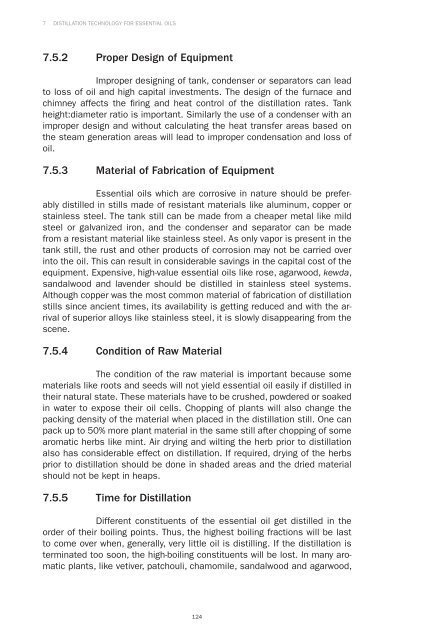Extraction Technologies For Medicinal And Aromatic Plants - Unido
Extraction Technologies For Medicinal And Aromatic Plants - Unido
Extraction Technologies For Medicinal And Aromatic Plants - Unido
You also want an ePaper? Increase the reach of your titles
YUMPU automatically turns print PDFs into web optimized ePapers that Google loves.
7 DISTILLATION TECHNOLOGY FOR ESSENTIAL OILS<br />
7.5.2 Proper Design of Equipment<br />
Improper designing of tank, condenser or separators can lead<br />
to loss of oil and high capital investments. The design of the furnace and<br />
chimney affects the fi ring and heat control of the distillation rates. Tank<br />
height:diameter ratio is important. Similarly the use of a condenser with an<br />
improper design and without calculating the heat transfer areas based on<br />
the steam generation areas will lead to improper condensation and loss of<br />
oil.<br />
7.5.3 Material of Fabrication of Equipment<br />
Essential oils which are corrosive in nature should be preferably<br />
distilled in stills made of resistant materials like aluminum, copper or<br />
stainless steel. The tank still can be made from a cheaper metal like mild<br />
steel or galvanized iron, and the condenser and separator can be made<br />
from a resistant material like stainless steel. As only vapor is present in the<br />
tank still, the rust and other products of corrosion may not be carried over<br />
into the oil. This can result in considerable savings in the capital cost of the<br />
equipment. Expensive, high-value essential oils like rose, agarwood, kewda,<br />
sandalwood and lavender should be distilled in stainless steel systems.<br />
Although copper was the most common material of fabrication of distillation<br />
stills since ancient times, its availability is getting reduced and with the arrival<br />
of superior alloys like stainless steel, it is slowly disappearing from the<br />
scene.<br />
7.5.4 Condition of Raw Material<br />
The condition of the raw material is important because some<br />
materials like roots and seeds will not yield essential oil easily if distilled in<br />
their natural state. These materials have to be crushed, powdered or soaked<br />
in water to expose their oil cells. Chopping of plants will also change the<br />
packing density of the material when placed in the distillation still. One can<br />
pack up to 50% more plant material in the same still after chopping of some<br />
aromatic herbs like mint. Air drying and wilting the herb prior to distillation<br />
also has considerable effect on distillation. If required, drying of the herbs<br />
prior to distillation should be done in shaded areas and the dried material<br />
should not be kept in heaps.<br />
7.5.5 Time for Distillation<br />
Different constituents of the essential oil get distilled in the<br />
order of their boiling points. Thus, the highest boiling fractions will be last<br />
to come over when, generally, very little oil is distilling. If the distillation is<br />
terminated too soon, the high-boiling constituents will be lost. In many aromatic<br />
plants, like vetiver, patchouli, chamomile, sandalwood and agarwood,<br />
124

















